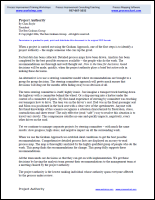
Project Authority
by Chris BoylePresident
The Ben Graham Group
© Copyright 2006, The Ben Graham Group. All rights reserved.
Links may be established to this paper.
When a project is carried out using the Graham Approach, one of the first steps is to identify a project authority – the single someone who can rap the gavel.
Factual data has been collected. Detailed process maps have been drawn. Analysis has been completed by the best possible resources available -- the people who do the work. The recommendations are thorough and well thought out. Now is the time for decisions. Good decisions will be made, quickly, when the project authority plays a brief but active role in making these decisions.

An alternative is to use a steering committee model where recommendations are brought to a group for group decision. The steering committee approach will pretty much ensure that decisions will drag out for months often fading away to no decision at all.
Provide your name and email to download the pdf...

The term steering committee is itself, highly ironic. Just imagine a transport truck hurtling down the highway with a committee behind the wheel. Or a ship moving into a harbor under the control of a committee of pilots. My first hand experience of steering by committee was teaching our teenagers how to drive. The teen was in the driver’s seat. Dad was in the front passenger seat and Mom was positioned in the back seat with a clear view of the speedometer. Anyone with first hand knowledge of this scenario recognizes a situation characterized by frustration, stress, contradiction and sheer terror! The only effective (read “safe”) way to resolve this situation is to travel very slowly. This compromise satisfies no one and quickly impacts, negatively, every other driver on the road.
Yet we continue to manage corporate projects by steering committee – with much the same results: slow progress; high stress; and negative impact on all of the surrounding work.
When we use the Graham Approach we establish ideal conditions to get the best possible recommendations. Comprehensive detailed process facts are displayed on an easy-to-read process map. The map is thoroughly analyzed by the highly qualified group of people who actually do the work. This group finds the recommendations for change. This group fully supports these recommendations.
All the team needs is decisions so that they can get on with implementation. We get these decisions by having the analysis team present their recommendations to the management team at a meeting chaired by the project authority.
The project authority is the lowest ranking individual whose authority spans everyone affected by the process under review.
At the beginning of the project we identify the project authority and request a brief meeting. During the meeting we brief the project authority on how the project will proceed and we say: “We are using the Graham Approach. At the conclusion of the project, the team of your people who actually do the work would like to present their recommendations. This presentation will be at a meeting comprising you and the managers of the areas involved with the process. At that meeting we will present, and be prepared to defend, every recommendation. We will come with the expectation that you will make a decision on each recommendation (and we will recognize that ‘no’ is one possible decision). Would that be OK?”
Every project authority I have worked with has recognized the benefits of making quick decisions on good recommendations and, has agreed.
As analysis progresses, we then arrange another brief meeting with the project authority. At that meeting we ask him or her to chair the meeting. We indicate that we will start the meeting by reading through the entire report (our reports are short so the reading usually takes only five or six minutes). Then we will go back to the first recommendation and begin dealing with them one by one. Each recommendation is discussed. When the managers have questions, the team members provide immediate answers. After discussion, the project authority looks around the table to the other managers and says something along the lines of “I guess that looks like a yes...”
Many recommendations are in management’s “zone of indifference” and receive easy approval. We always advise management that if they need to say “no” to a recommendation, that is OK, but it will not mean no for the entire project because most of the recommendations are independent of each other (This is because the process maps enable the team to work at what we call “the elemental level”.) It is better to have one recommendation rejected than to hold up an entire list of good recommendations. If management needs to say “no”, it may be because management knows something that the analysis team does not know.
Sometimes management will be unwilling to accept a recommendation without further work. More analysis is required. In this case we recommend that the project authority delegate the additional analysis. We also recommend delegating the decision to an appropriate manager. This decision should be made within one or two weeks (with the time frame established up front). If the decision is going to take longer, it will default to the “rejected” column.
We recommend not releasing a copy of the recommendations prior to the presentation meeting. The reason for not releasing ahead of time is that these recommendations are not intended to stand on their own. They are intended to be elaborated on and supported by the people who have spent a great deal of time doing thorough analysis. In the absence of supporting voices, there is a real danger that individual managers will jump to invalid conclusions. Unfortunately these invalid conclusions can have serious political repercussions at proposal presentation (This is the concept of “completed staff work” where the staff that did the analysis is available to answer questions when the report is read.)
We sometimes run into the objection: “That will never work here. Our management needs to see a copy ahead of time. That’s the way we’ve always done it.” We are not suggesting that management be blind-sided the day before the presentation with a refusal to release the report. Address this issue with the project authority during the first meeting: “Oh, by the way, we will not be releasing the proposal ahead of time, because it is not intended to be a stand-alone document.”
In summary, find the single someone who can rap the gavel, get decisions and get on with implementation!
____________________Chris Boyle is president of The Ben Graham Group in Winnipeg, MB and has been working with the Graham methodology for over twenty-five years. Chris has recently facilitated projects in such diverse organizations as a nuclear generating station, a college, a smelting company and a judicial prosecutions office.